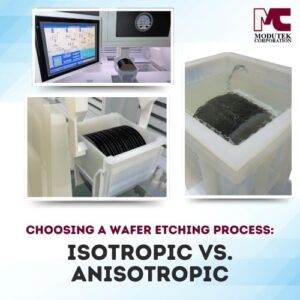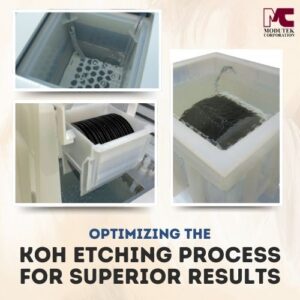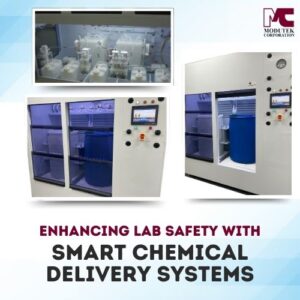![]() Silicon wet etching equipment is required in the manufacture of semiconductor components and selecting the right equipment is essential for maintaining facility performance and excellent product quality. The products produced from these facilities range from relatively simple electronic parts to complex components with intricate microstructures and an electronic/physical structure interaction. These varying requirements mean that most systems have to be customized for the specific application.
Silicon wet etching equipment is required in the manufacture of semiconductor components and selecting the right equipment is essential for maintaining facility performance and excellent product quality. The products produced from these facilities range from relatively simple electronic parts to complex components with intricate microstructures and an electronic/physical structure interaction. These varying requirements mean that most systems have to be customized for the specific application.
Selecting wet etching equipment along with related accessories and controls may require expert help because the system parts have to be closely integrated and seamlessly take the silicon wafers through many fabrication steps. Precision dosages, accurate temperature control and exact timing are important for consistency. Manufacturers who assemble their own equipment and program their own software will be able to give the most useful advice on system selection.
Getting the Right Tanks and Baths
Tanks made of different materials and with different options support different chemical processes. Quartz baths are used for cleaning with processes such as RCA and SPM while Teflon tanks are used for etching applications such as KOH and TMAH. Stainless steel tanks are for solvent baths and all the tanks have to be made from high-quality materials that reduce contamination.
Tank features that are specific to various processes can include heating, cooling and re-circulating. Chemicals are heated to speed up etching and cleaning but the temperature has to be tightly controlled to ensure etching is precise and repeatable. Sub-ambient filtered etch baths are used with buffered oxide etch (BOE) and can operate in a 10 to 60 degree Celsius temperature range. Recirculation keeps the temperature constant and can include filtering.
Silicon nitride wet etching is a special case because the baths need a two-tier control system that avoids temperature bumps from the addition of water to the phosphoric acid used in the process. Control measures are needed to maintain the water acid ratio by adding small amounts of water while ensuring that the water immediately mixes with the acid. If an application requires nitride etch, this type of control feature is essential.
Automation Can Improve Throughput and Yield
Automation of different process steps can make the process run exactly as desired and allows operators to program variables with excellent results for subsequent batches. Wet benches can be operated manually, semi-automatically or with full automation. Manual control lets operators set process parameters and calculate chemical doses before starting and monitoring the process. In semi-automatic operation, many of the process steps are carried out robotically but still under the control of the operator. Full automation runs the entire process.
Automation impacts the performance of silicon wet etching equipment in several ways, including the following:
- Reduced human error.
- Reduced chemical use
- Increased etching accuracy
- Improved etch rates
These factors become especially important with semiconductor products in which components are densely packed or which have intricate microstructures. Better control of temperatures, dosages and timing means product defects are fewer, yields are higher and product quality is improved. Running the same automated program again results in excellent repeatability. Reducing operator interaction with harmful chemicals increases safety and employee job satisfaction.
Modutek Provides Industry-Leading Silicon Wet Etching Equipment
Modutek can provide silicon wet etching equipment for all common wet bench processes and has the expertise to customize systems for specific customer applications. All equipment is assembled in house at the San Jose, California facility and the software is designed and programmed by the company’s specialists. Modutek has extensive experience in semiconductor manufacturing equipment and can help customers select the best silicon wet etching systems to satisfy their requirements.
Reviewed and Approved by Douglas Wagner
President & CEO, Modutek Corporation




